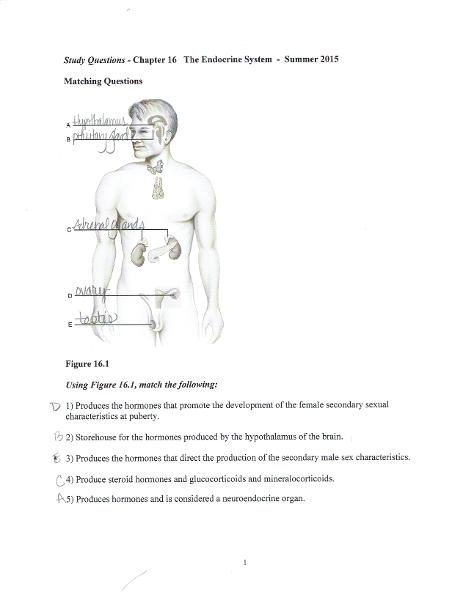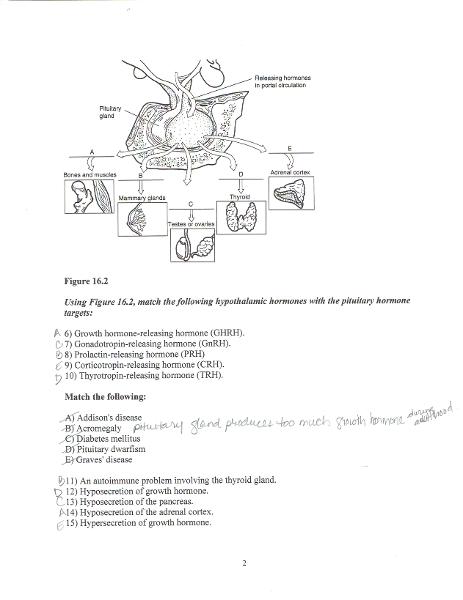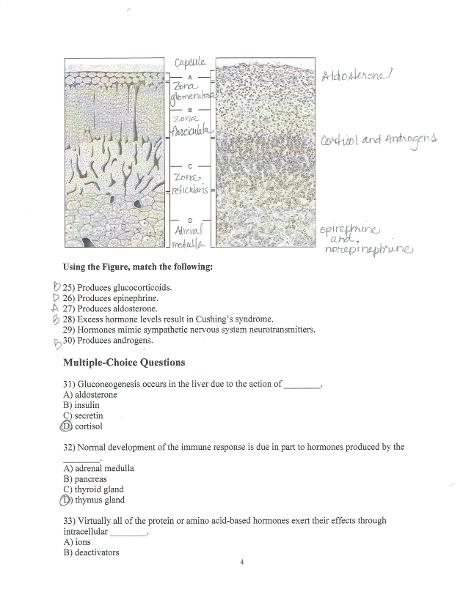Chp. 16 Endocrine System Study Questions

Ovary - produces the hormones that promote the development of the female secondary sexual characteristics at puberty.
Pituitary gland - storehouse for the hormones produced by the hypothalamus of the brain.
Testis - Produces the hormones that direct the production of the secondary male sex characteristics.
Adrenal glands - Produce steroid hormones and glucocorticoids and mineralocorticoids
Hypothalamus - Produces hormones and is considered a neuroendocrine organ.

Bones and muscles - Growth hormone-releasing hormone (GHRH)
Mammary glands - Prolactin-releasing hormone (PRH)
Testes or ovaries - Gonadotropin-releasing hormone (GnRH)
Thyroid - Thyrotropin-releasing hormone (TRH)
Adrenal cortex - Cortocotropin-releasing hormone (CRH)
Addison's disease - hyposecretion of the adrenal cortex
Acromegaly - autoimmune problem involving the thyroid gland
Diabetes mellitus - hyposecretion of the pancreas
Pituitary dwarfism - hyposecretion of growth hormone
Graves disease - hypersecretion of growth hormone
Cushing's disease - hypersecretion of adrenal cortex
Myxedema - hyposecretion of thyroid in adults
Acromegaly - hypersection of growth hormone
Cretinism - hyposecretion of thyroid in infants
Thyroid - produces the body's major metabolic hormones
Adrenal medulla - gland that controls the fight-or-flight reaction
Hypophysis - the size and shape of a pea: produces hormones that stimulate other endocrine glands.
Parathyroid - produces a hormone that controls blood levels of calcium and potassium by their removal from bone tissue.
Pancreas - produces hormones that regulate glucose levels in the body.

Zona glomerulosa - produces aldosterone
Zona fasciculate - produces glucocorticoids, produces androgens, excess hormone levels result in Cushings syndrome.
Adrenal medulla - produces epinephrine, hormones mimic sympathetic nervous system neurotransmitters
Gluconeogenesis occurs in the liver due to the action of _______
cortisol
Normal development of the immune response is due in part to hormones produced by _____
thymus gland
All of the protein or amino acid-based hormones exert their effects through intracellular _______
second messengers
What is not a category of endocrine gland stimulus
enzyme
Chemical substances secreted by cells into the extracellular fluids and that regulate the metabolic function of other cells in the body are called ________
hormones
The hypothalamic-hypophyseal tract
partly contained within the infundibulum
Oxytocin
release is an example of a positive feedback control mechanism
ADH
Is inhibited by alcohol
Thyroid hormone exerts its influence by
entering some cells and binding to intracellular receptors within the nuclei
Gonadocortioids
production by the adrenal gland is insignificant compared with sex hormone release from the gonads during late puberty
Prolonged excessive exposure to high hormone concentrations causes a phenomenon known as
down-regulation
What is not a change that may be caused by hormonal stimulus?
direct control of the nervous system
The ability of specific tissue or organ to respond to the presence of a hormone is dependent on?
the presence of the appropriate receptors on the cells of the target tissue or organ
Several hormones are synthesized in the hypothalamus and transported to the anterior pituitary gland. The mechanism of transportation from hypothalamus to anterior pituitary gland is through the _______
hypophyseal portal system
The neurohypophysis or posterior lobe of the pituitary gland is not a true endocrine gland because _____
it is only a hormone storage area that receives hormones from the hypothalamus for release
Steroid hormones exert their action by ______
entering the nucleus of a cell and initiating or altering the expression of a gene
The second messenger mechanism of hormone action operates by ?
binding to specific receptors and employing the services of G proteins and cAMP
Hormones often cause a cell to elicit multiple responses; this is because?
during protein kinase activation, enzymes phosphorylate many other enzymes
Cells that respond to peptide hormones usually do so through a sequence of biochemical reactions involving receptor and kinase activation. In order for cells to respond , It is necessary for first and second messengers to communicate. This is possible because _____
G protein acts as the link between first and second messengers
Thyroid hormone enters target cells in a manner similar to_____
steroid hormones, because both diffuse easily into target cells
When it becomes necessary to enlist the fight-or-flight response, a hormone that Is released during the alarm phase of the general adaption syndrome is ________
epinephrine
One of the least complicated of the endocrine control systems directly responds to changing blood levels of ions and nutrients. Which describes this mechanism?
humoral stimulation
The major targets of growth hormones are ______
bones and skeletal muscles
The parathyroid glands maintain adequate levels of blood calcium. This is accomplished through _____
targeting the bone and activating osteoclasts so that calcium will be released
Which organ is responsible for synthesizing ANP?
the heart
Mineralocorticoid is to aldosterone as glucocorticoid is to ______
cortisol
adipocytes
The most important regulator of electrolyte concentrations in extracellular fluids is ______
aldosterone
What is not a steroid based hormone?
epinephrine
Which of the following would be associated with the action of steroids on cells?
a hormone-receptor complex that interacts directly with the cells DNA
Cellular responses to hormones that initiate second-messengers systems include ___
possible activation of several different second-messenger systems
Regulating hormones from the hypothalamus ______
first enter into the hypophyseal portal system
ACTH _______
secretion is regulated by a hypothalamic secretion
What is true about calcium homeostasis?
Parathyroid hormone is the single most important regulator of calcium levels in the blood
Aldosterone ________
functions to increase sodium reabsorption
The only amine hormone to act like a steroid is ______
TH
Which organ does not have a hormone production?
liver
In circumstances where the body requires prolonged or increased levels of a hormone, the DNA of target cells will specify the synthesis of more receptors on the surface of the cells of the target organ. This is known as ______
up-regulation
Eicosanoids do not include _____
hydrocortisones
A man was told that he is not synthesizing enough FSH, and for this reason he ay be unable to father a child. Explain this problem...
FSH stimulates sperm production in the testes
What organ is affected by thyroid hormone in adults?
liver
Thyroxine is a peptide hormone, but it's mechanism is different from other peptide hormones. Why is this _____
it does not require a second messenger to effect a response
How do glucocorticoids enable the body to deal appropriately with stress?
by increasing blood glucose, fatty acid, and amino acid levels and enhancing blood pressure
What ion is sometimes used as a second messenger of amino acid based hormones?
calcium
What hormones are synthesized from cholesterol?
Steroids
________ is a hormone that has only one known effect: to stimulate milk production by the breasts.
Prolactin
________ are the result of hypersecretion of growth hormone
acromegaly & gigantism
The largest pure endocrine gland in the body is the ______
thyroid
Which hormone stimulates production of RBC's and which organ or structure produces it?
erythropoietin, kidneys
Alpha islet cells produce _______, an extremely potent hyperglycemic hormone
glucagon
The _____ gland my influence our day/night cycles and even regulate the onset of sexual maturity
pineal
The ____ gland declines in size and function with age
thymus
Endocrine gland stimuli include hormonal, _____, and ______ stimuli
humoral, neural
As a result of stress, the adenohypophysis releases _____, which stimulates release of hormones from the adrenal cortex that retain sodium and water, increase blood sugar and begin breaking down fats.
ACTH